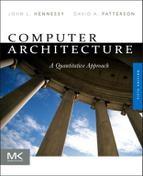L
L1 caches See also First-level caches
address translation, B-46
Alpha 21164 hierarchy, 368
ARM Cortex-A8 vs. A9, 236
ARM Cortex-A8 example, 117
cache optimization, B-31 to B-33
directory-based coherence, 418
Fermi GPU, 306
hardware prefetching, 91
hit time/power reduction, 79–80
memory consistency, 392
memory hierarchy, B-39
miss rates, 376–377
multiprocessor cache coherence, 352
multiprogramming workload, 374
nonblocking cache, 85
NVIDIA GPU Memory, 304
Opteron memory, B-57
processor comparison, 242
speculative execution, 223
T1 multithreading unicore performance, 228
virtual memory, B-48 to B-49
L2 caches See also Second-level caches
ARM Cortex-A8 example, 117
case study example, B-63 to B-64
coherency, 352
commercial workloads, 373
fault detection, 58
hardware prefetching, 91
and ISA, 241
memory consistency, 392
nonblocking cache, 85
NVIDIA GPU Memory, 304
processor comparison, 242
snooping coherence, 359–361
speculation, 223
L3 caches See also Third-level caches
Alpha 21164 hierarchy, 368
coherence, 352
inclusion, 398
memory access cycle shift, 372
miss rates, 373
multicore processors, 400–401
multithreading, 225
nonblocking cache, 83
performance/price/power considerations, 52
Lanes
GPUs vs. vector architectures, 310
vector execution time, 269
vector instruction set, 271–273
Vector Lane Registers, 292
LANs See Local area networks (LANs)
Latency See also Response time
advanced directory protocol case study, 425
and cache miss, B-2 to B-3
directory coherence, 425
dynamically scheduled pipelines, C-70 to C-71
FP operations, 157
FP pipeline, C-66
functional units, C-53
GPU SIMD instructions, 296
GPUs vs. vector architectures, 311
hazards and forwarding, C-54 to C-58
hiding with speculation, 396–397
ILP exposure, 157
ILP without multithreading, 225
ILP for realizable processors, 216–218
microarchitectural techniques case study, 247–254
MIPS pipeline FP operations, C-52 to C-53
misses, single vs. multiple thread executions, 228
multimedia instruction compiler support, A-31
NVIDIA GPU Memory structures, 305
out-of-order processors, B-20 to B-21
parallel processing, 350
performance milestones, 20
pipeline, C-87
ROB commit, 187
shared-memory workloads, 368
snooping coherence, 414
Sun T1 multithreading, 226–229
WSC efficiency, 450–452
WSC processor cost-performance, 472–473
WSCs vs. datacenters, 456
Layer 3 network, array and Internet linkage, 445
Layer 3 network, WSC memory hierarchy, 445
LCA See Least common ancestor (LCA)
LCD See Liquid crystal display (LCD)
Learning curve, cost trends, 27
Level 3, as Content Delivery Network, 460
Limit field, IA-32 descriptor table, B-52
Line, memory hierarchy basics, 74
Link register
MIPS control flow instructions, A-37 to A-38
procedure invocation options, A-19
synchronization, 389
Linpack benchmark
vector processor example, 267–268
Linux operating systems
Amazon Web Services, 456–457
architecture costs, 2
protection and ISA, 112
WSC services, 441
Literal addressing mode, basic considerations, A-10 to A-11
Liveness, control dependence, 156
Livermore Fortran kernels, performance, 331, L-6
LMD See Load memory data (LMD)
Load instructions
control dependences, 155
data hazards requiring stalls, C-20
dynamic scheduling, 177
loop-level parallelism, 318
memory port conflict, C-14
pipelined cache access, 82
RISC instruction set, C-4 to C-5
Tomasulo’s algorithm, 182
VLIW sample code, 252
Load locked, synchronization, 388–389
Load memory data (LMD), simple MIPS implementation, C-32 to C-33
Load stalls, MIPS R4000 pipeline, C-67
Load-store instruction set architecture
basic concept, C-4 to C-5
Intel Core i7, 124
as ISA, 11
ISA classification, A-5
simple MIPS implementation, C-32
VMIPS, 265
Load upper immediate (LUI), MIPS operations, A-37
Local address space, segmented virtual memory, B-52
Locality See Principle of locality
Local Memory
centralized shared-memory architectures, 351
distributed shared-memory, 379
Fermi GPU, 306
Grid mapping, 293
multiprocessor architecture, 348
SIMD, 315
symmetric shared-memory multiprocessors, 363–364
Local miss rate, definition, B-31
Local node, directory-based cache coherence protocol basics, 382
Local optimizations, compilers, A-26
Local predictors, tournament predictors, 164–166
Local scheduling, ILP, VLIW processor, 194–195
Lock-up free cache, 83
Long-haul networks See Wide area networks (WANs)
Loop-carried dependences
CUDA, 290
definition, 315–316
dependent computation elimination, 321
GCD, 319
as recurrence, 318
VMIPS, 268
Loop exit predictor, Intel Core i7, 166
Loop interchange, compiler optimizations, 88–89
Loop-level parallelism
definition, 149–150
detection and enhancement
basic approach, 315–318
dependence computation elimination, 321–322
dependences, locating, 318–321
ILP in perfect processor, 215
ILP for realizable processors, 217–218
Loop stream detection, Intel Core i7 micro-op buffer, 238
Loop unrolling
basic considerations, 161–162
ILP exposure, 157–161
ILP limitation studies, 220
VLIW processors, 195
LRU See Least recently used (LRU)
LUI See Load upper immediate (LUI)
..................Content has been hidden....................
You can't read the all page of ebook, please click here login for view all page.
